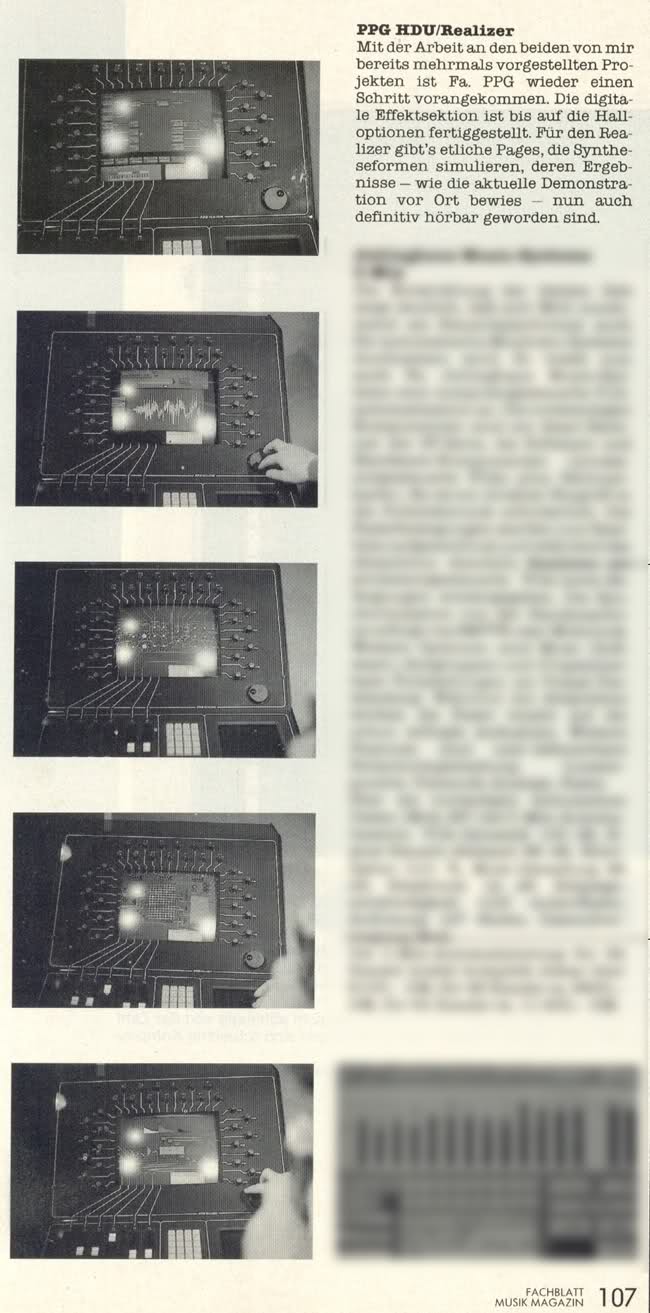The PPG Story
The circuit boards were eventually finished some time in the summer of ’86, the software ran and the first HDU’s were delivered. But again there were problems. Some hardware issues could be quickly resolved, but the software was more difficult.
If I now look how much code and how many functions are in the HDU, I'm surprised that it all managed run considering the primitive development systems of that time. The "C" programming language existed, but it was not available on our systems. So as before we had to program in assembler language!
Another problem was that the customers were not satisfied with the "time correction". We had always demonstrated this smoothly at the fairs, but with certain audio material the "time correction" was totally unsatisfactory (it has also taken years until better algorithms arose, but they also required much more computing power).The Realizer was developed in parallel - with better colour graphics, more sample memory and better DSP algorithms. The price was in a similar range to the Fairlight or Synclavier, which only made it available to the few. Not everyone could afford them - unless of course that had just had a Megahit!
A completely different (but perhaps the biggest) problem was that now the Wave sales slowly decreased. This was due on one hand to the DX7, which was now very popular, but also because of the small samplers from Ensoniq etc. The Kurzweil was now also volume production.
Therefore things became financially tighter at PPG and I was forced to dismiss people, which was of course very painful. Nobody could or wanted to understand why particularly they had to go! The whole working environment became increasingly intolerable. In addition to that, my marriage was in crisis!
We still went to the ’87 Frankfurt fair, where we tried to get dealers to invest, but later in the year decided to implement the liquidation of the company. (PPG was not bankrupt, as I've ever read, but was very cleanly dissolved).
Wolfgang Düren then made contact with Steinberg. I demonstrated the Realizer to Manfred Rürup, Karl Steinberg and a few developers, and it was probably clear to them that they saw the future before them (albeit in another form and on other hardware). It then continued at Steinberg for me and 2 programmers.
Frankfurt Messe Review in german magazine "Fachblatt MusikMagazin" from Mai, 1987
The picts where shot directly while I gave them a demo. The text says:
PPG HDU/Realizer
With the work done on both of the projects, which I have demonstrated more than once, PPG has once more made progress. All but the reverb options of the digital effects section are finished. There are many pages simulating different forms of synthesis for the Realizer which are now - like the demonstration has shown - definitely detectable by listening.

Irgendwann im Sommer '86 waren dann endlich die Platinen fertig, die Software lief und es wurden die ersten HDUs ausgeliefert. Aber es gab wieder mal Probleme. Einige Hardwaresachen konnten schnell bereinigt werden, mit der Software war das schwieriger.
Wenn ich mir heute ansehe, wieviel Programmcode und wie viele Funktionen in der HDU sind, wundere ich mich sowieso, wie das alles mit den primitiven Entwicklungssystemen der damaligen Zeit laufen konnte. Es gab zwar schon die "C"-Programmiersprache, die war aber auf unseren Systemen nicht verfügbar. Also mussten wir nach wie vor alles in Assembler programmieren!
Ein anderes Problem war, dass die Kunden mit der "Timecorrection" unzufrieden waren. Wir hatten das auf den Messen und sonstigen Vorführungen immer schön dargestellt, aber mit bestimmtem Audiomaterial war die "Timecorrection" total unbefriedigend (es hat auch noch Jahre gedauert, bis bessere Algorithmen entstanden, die aber auch wesentlich mehr Rechenpower benötigen).
Der Realizer wurde parallel weiterentwickelt - mit besserer Farbgrafik, mehr Sample-Memory und besseren DSP-Algorithmen. Die Preiskategorie bewegte sich im selben Rahmen wie das Fairlight oder Synclavier und kam damit nur für wenige in Frage. So etwas kauft man nicht mal eben schnell - es sei denn man hat gerade einen Megahit!
Ein ganz anderes (aber vielleicht das grösste) Problem war, dass nun langsam die Wave-Verkäufe zurückgingen. Das lag zum einen am DX7, welches jetzt sehr pupolär war, aber auch an kleinen Samplern von Ensoniqu etc. Das Kurzweil lief jetzt auch in Stückzahlen.
Es wurde daher bei PPG finanziell immer enger und ich musste Leute entlassen, was natürlich sehr schmerzlich war. Niemand konnte oder wollte verstehen, warum nun gerade er gehen musste! Die ganze Arbeitssituation wurde immer unerträglicher. Hinzu kam noch, dass es in meiner Ehe kriselte!
Wir haben dann '87 noch die Frankfurter Messe gemacht und versucht, Händler zu Investitionen zu bewegen, aber später im Jahr die Liquidation beschlossen und durchgeführt. (PPG ging also nicht pleite, wie ich es schonmal gelesen habe, sondern wurde ganz sauber aufgelöst).
Wolfgang Düren stellte dann einen Kontakt zu Steinberg her. Ich führte Manfred Rürup, Karl Steinberg und ein paar Entwicklern den Realizer vor, und ihnen war wohl klar, dass hier die Zukunft vor ihnen ausgebreitet liegt (nur eben in anderer Form und auf anderer Hardware). Für mich und 2 Programmierer ging es dann bei Steinberg weiter.
Volker Barber demonstrating the HDU in 1987.
In the left you see the new version of the Realizer, with the new console.